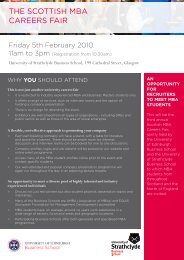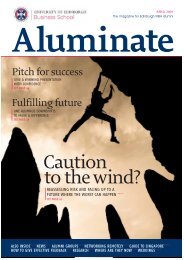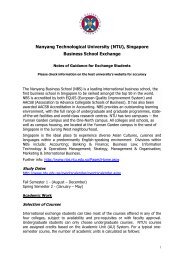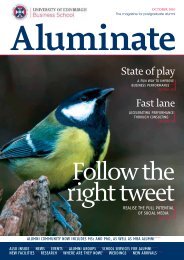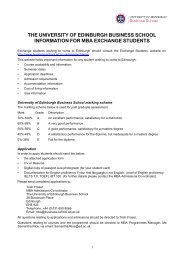killed Saab Automobile? - Business School - University of Edinburgh
killed Saab Automobile? - Business School - University of Edinburgh
killed Saab Automobile? - Business School - University of Edinburgh
Create successful ePaper yourself
Turn your PDF publications into a flip-book with our unique Google optimized e-Paper software.
The automotive industry typically suffers earlier and deeper recessions than other sectors lxviii , as<br />
customers can usually postpone the purchase <strong>of</strong> cars in the face <strong>of</strong> financial uncertainty. This<br />
particularly hurts financially marginal companies, who may already face relatively weak demand and<br />
who lack a substantial financial buffer to ride out the storm. So it was with <strong>Saab</strong> who saw an 80% drop<br />
in demand, from which it has never recovered.<br />
This loss in volume had obvious financial consequences, as the next chart shows. Yet even prior to the<br />
financial crisis <strong>Saab</strong> was largely loss-making, returning a small pr<strong>of</strong>it in only three <strong>of</strong> the 20 years that<br />
GM owned it (1994, 1995, and 2001).<br />
The increase in revenue in 2009 resulted from selling equipment for the older generation 9-3 and 9-5<br />
models to BAIC for US$197 million, and so does not represent an improved trading position. The<br />
company also de-stocked significantly, selling around 10,000 more cars than it made in this year.<br />
In 2011, matters took a turn for the worse: the first six months to June saw losses rise nearly ten-fold to<br />
€201.5 million ($289 million) from €21.9 million for the same period in 2010. By this point <strong>Saab</strong> had run<br />
up short-term debt <strong>of</strong> the same value as its entire 2010 sales revenues.<br />
30,000<br />
25,000<br />
20,000<br />
15,000<br />
10,000<br />
5,000<br />
0<br />
-5,000<br />
-10,000<br />
Financial performance, 2000-2010<br />
2000 2001 2002 2003 2004 2005 2006 2007 2008 2009 2010<br />
Revenue (MSEK) After tax pr<strong>of</strong>it (MSEK)<br />
FIGURE 2: SAAB'S FINANCIAL PERFORMANCE. SOURCE: ANNUAL REPORTS<br />
Most company failures involve poor management decisions at certain points in the company’s history,<br />
although the quality or otherwise <strong>of</strong> such decisions may only be apparent with hindsight. Such<br />
decisions may result in poor allocation <strong>of</strong> resources, missed market opportunities, or failure to promote<br />
and sustain the brand and image <strong>of</strong> the company, thereby threatening the success <strong>of</strong> the firm in the<br />
market. Was <strong>Saab</strong>’s failure a function <strong>of</strong> poor management?<br />
To answer this question one has to understand the economies <strong>of</strong> scale that underpin the auto industry.<br />
While it was common up to the 1990s to develop and build stand-alone models (i.e. each model had its<br />
22





